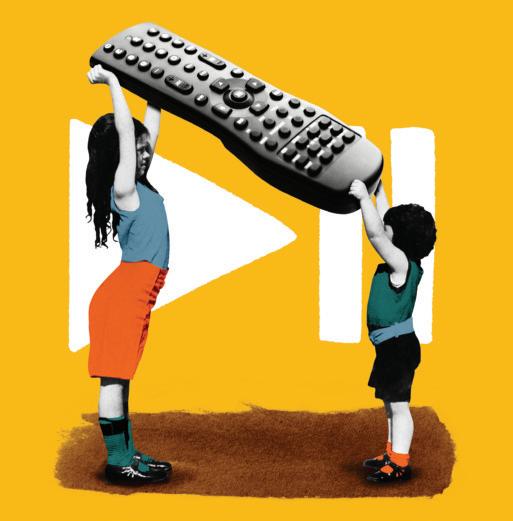
15 minute read
ACTIVITIES
e psychology of screens
From video games and apps to YouTube and Netf lix, screen time has been a pandemic saviour for many parents. Still, you may be concerned about the number of hours your kids have been clocking on their devices—and how you’ll ever get back to your pre-pandemic rules. We assembled a group of experts to get some real answers about the emotions (your kids’ and your own) and the science (are kids hard-wired to love screens?) of screens.
Advertisement
THROUGHOUT MY 13 YEARS as a parent, the amount of time my three kids have spent on screens has ebbed and flowed with the chaos and stress going on at home. There were the months when, after her baby brother was born, our threeyear-old would wake up at 5:30 a.m., climb into our bed and start her morning with a healthy dose of The Big Comfy Couch and whatever else was on at that ungodly hour. Then there was the time after our third child was born and we’d just moved into a new house. The two-year-old sat, surrounded by boxes, sucking his milk bottle, tiny hand tucked into his diaper, watching Monsters Inc. for days.
I look back on these chapters as our “seasons of screens,” where there was just too much going on in our lives to be fully imaginative and engaged when it came to parenting. When we really just needed to park them somewhere and know they were happy and safe. When there really wasn’t another choice.
Enter the COVID-19 pandemic and parents everywhere have been in a universal, seemingly never-ending “season of screens.” More than a year after the initial shock of school and daycare closures, cancelled extracurriculars and a ban on family visits, our kids are still exposed to way more screens than they were pre-pandemic because, well, we’re still living through it.
I haven’t been feeling great about my kids’ pandemic screen time, yet I know it’s unrealistic for me to uphold the pre-pandemic rules I used to have in place. So I assembled a team of experts to find out exactly what we parents need to worry about and what we can let go. Here’s what I learned.
WHY ARE KIDS SO ENTRANCED BY SCREENS? Kids get so zoned in on screens because the people who create apps and television shows for children are specifically designing them in a way that grabs their attention. “They change constantly and they provide what they call variable rewards to keep us hooked,” explains Pamela Hurst-Della Pietra, president of Children and Screens: Institute of Digital Media and Child Development, a nonprofit organization that studies the impact of tech on children. “For little kids, screens are full of stimuli—they’re noisy, they’re colourful, they’re constantly changing and they involve multiple senses at the same time.” Kids have always loved TV, but with so many more content options and devices to watch or play on, they are less likely to get bored and walk away on their own.
Sukhpreet Tamana, a clinical child psychologist and researcher in the faculty of health sciences at Simon Fraser University who has studied screen time in preschoolers, says three-, four- and five-year-olds are especially susceptible to the
five-year-olds are especially susceptible to the allure of a device. “They’re still trying to develop that delayed gratification and that ability to regulate their emotions,” she explains. “On devices, everything is happening fast and there’s no pause between what’s happening for you and what’s happening on the screen.” Compare this to, say, a playground, where a kid’s experience and enjoyment is contingent on the actions of others.
IS ALL SCREEN TIME EQUAL? Pre-pandemic, researchers looked at screen use through what’s called the displacement hypothesis. “The idea is that any time spent on a technology is time that is displacing something better in a child’s life,” says digital technologies researcher Amy Orben from the University of Cambridge in England. But the theory stopped making sense during the pandemic, she says. “This displacement idea didn't really work anymore, because we could not just go outside, we could not go to an after-school class. The screen became a vehicle for all these positive actions.”
So if you’re adding up the amount of time your kid is on a screen, experts say not to include video calls with family or any education-related screen time. Educational apps, interactive videos where kids are dancing or singing along, and watching a movie as a family are also all more positive uses of screens compared to, for example, a kid sitting on their own, headphones on, watching poorly produced YouTube videos chosen by an algorithm.
Video games can also be a positive use of screens if they are playing online with friends, says Michelle Ponti, cha ir of the Ca nadia n Paediatric Society’s Digital Health Task Force and a paediatrician in London, Ont. “That’s how they’re staying connected.” Games that get kids off the couch and moving around are great too, she says.
You can also encourage older kids to do something useful on their devices, like looking up videos for an upcoming school project, comparing styles of bikes if they need a new one or researching potential destinations for a post-pandemic family vacation.
Ponti cautions that there are no benefits to kids under two using screens, so screen time should be as limited as possible, although video calls with family members are perfectly fine.
WHAT ARE THE SIGNS MY KID NEEDS TO CUT BACK? Some research shows a possible link between excessive screen use and things like poor sleep and childhood obesity, although a causal relationship has not been proven, says Hurst-Della Pietra.
Regardless, experts encourage concerned parents to simply take a good look at what’s actually going on in their homes. “Screens don’t cause inv isible da mage to children,” says A nya Kamenetz, author of The Art of Screen Time. So if you’re trying to spot signs that your kid might be overdoing it, she says, “you’re looking for impairment in basic functions, like they’re not sleeping well or they’re not interested in stopping to eat. Or they’re not showing a lot of interest in relating to their family members because they want to be involved in what’s happening on the screen.” Hurst-Della Pietra says to also watch for an increase in apathy, emotional outbursts and anxiety, plus missed milestones in physical, emotional and language development.
Tamana, whose 2019 research found an association between increased screen time and attention problems in preschoolers, says her study a lso discovered things that protected k ids against these negative effects, such as a goodquality sleep and taking part in structured activities throughout the day.
IS IT OK TO HAVE KIDS EARN THEIR SCREEN TIME? Ponti, for one, has no problem with this. “It’s a very powerful currency,” she says. So if you know your kid is going to be on their screens any way but you want them to do some chores, too, it’s completely reasonable to say they first need to clean their room, help put the groceries away or get their schoolwork done. “The caveat is, if a child starts whining and complaining about the chores and the parent gives in because they’re sick of it and gives them the screen, then they just rewarded that negative behaviour,” says Ponti. For some kids, sticker charts work well so they can visually track what they are earning.
HOW BAD IS IT THAT I’M ALWAYS CHECKING MY PHONE IN FRONT OF MY KIDS? A lot of parents find themselves on their phones more than ever during the pandemic, as a way to stay in touch with the outside world (or, in some cases, as an attempt to avoid the chaos of the inside world!). But let’s be honest: Most of us were pretty attached to our phones before COVID, too.
Obviously, it’s a wise idea to try to model good screen habits when your kids are around. But experts say that doesn’t necessarily mean hiding your phone use from your kids or feeling guilty about the time you’re spending on your device.
In stead, ma ke su re t he y s ee you t a k i ng brea ks from your phone when you’re directly interac t ing w it h t hem, a nd for t hings li ke meals and outdoor exercise. And don't let your device be seen as a barrier to communicating
with you. “Our interactions with our kids help them to learn about and manage their emotions,” says Kamenetz.
Ponti specifically recommends putting your device completely away for at least 10 minutes when your kids get home from camp, school or daycare so you can reconnect with them uninterrupted. Tamana suggests everyone in the family puts their devices away at dinnertime, and then again at bedtime. “Parents can hop back on once the kids are asleep.” (Ha. Obviously! )
HOW DO I EVEN START TO WEAN MY KIDS OFF THEIR PANDEMIC SCREEN HABITS? It might be tough to entice your kids away from them once it’s possible to socialize with other households or enrol in regular activities again. “Think about it like how we transition our kids from holidays back to routine,” Tamana suggests, and take it slow.
Kamenetz notes that parenting and family life are always evolving. “Whether or not there’s a pandemic, you’re going to have different rules six months from now than you do today and your child will discover new interests and they’ll have different friends,” she says. At the same time, some habits kids have picked up this past year will continue post-pandemic—and they might not all be negative, like using devices to call friends or family members. “I think we’ll see school districts responding as well, perhaps with more flexibility to accommodate kids who may have discovered while they’ve been home and learning that there are some advantages to that.”
I’M PRET TY WORRIED ABOUT THE LONG-TERM EFFECTS OF ALL THIS SCREEN TIME ON KIDS. SHOULD I BE? Experts are divided on how concerned we should be about kids and screens. It can be reassuring, though, to look at it from a historical perspective. “In the 1940s, there were scientific papers saying that radio might be an addictive substance for children, and that radio and movie dramas might be changing their body physiology and changing their attention,” says Orben. Today, of course, we’d be delighted if our kids were entertained by a simple radio drama.
In the end, we need to recognize that parenting is hard and relentless. If you’re at a breaking point, parking your kid in front of a device might actually be the best thing for them. Take it from Tamana: “If it’s a choice between the parent feeling really stressed and overwhelmed and not being emotionally available versus allowing the kid to use their screens while the parent is trying to keep things together, it’s probably better to give the kid their device.”—Claire Gagné
T V TWEAKS
My screen-time guilt was through the roof, so I made four simple changes—and now I feel so much better.
It was Saturday morning and I was watching TV with my two school-age kids when an error message suddenly popped up on the screen .
“I can fi x this,” my seven-year-old announced, jumping up and manipulating the cable box, then cycling through input options on the remote before ge ing us back to our show .
“How do you know how to do that?” I asked.
She shrugged. “It happens a lot, and I watch a lot of TV.”
Straight out of the mouths of babes.
She was right, though. My kids were watching a lot more TV than before the pandemic, and I’d been feeling increasingly confl icted about it. So I decided to reframe how I look at screen time, and tweak the way we handle TV watching in four small but meaningful ways— and I’m feeling so much be er about it now.
1 My kids now earn their TV time If they want to watch a show, they have to pay with a pompom, and they earn pompoms by doing simple chores, like tidying the shoes at the door or se ing the table for dinner. Or they can spend 15 minutes engaging in an activity like colouring, reading or playing. Ideas for chores and activities are wri en on ice-pop sticks in the kitchen, so they need minimal help from me. This tactic has made my kids a lot more appreciative of screen time. And because their pompom stash isn’t usually very robust, they o en have to take a break between episodes to come earn more. Sometimes they forget about their show altogether.
2 I’m more discerning about programming When they get sucked into a Netfl ix free-for-all, my kids end up watching wildly inappropriate shows for their ages and fi ght constantly over who gets to choose the next one. Now I steer them toward specifi c TV networks with programming geared toward their ages or I pick the show for them, focusing on ones that hold a bit more value (my faves are Odd Squad, Let’s Go Luna and If I Were an Animal). My kids still might get more TV than they used to, but they also learn about hibernation, where Brazil is and how fractions work.
3 We have TV time together As part of my commitment to be more present with my children, I’m trying to watch more TV with them—and wow, they really love it. Plus, it lets me engage with them about the show afterwards. Last week, for example, we watched an episode of Wild Kra s about fl amingos, and a erwards we downloaded and listened to a kids’ podcast all about fl amingos to keep the conversation going .
4 No TV after dinner There’s some evidence to suggest that screen use close to bedtime can impact sleep cycles. So unless it’s a special treat or a movie night, we try to keep the TV off a er 6 p.m. Instead, I’m looking for more meaningful ways to spend “offl ine” time together in the evening, like playing board games, reading, listening to podcasts or meditating—a wonderful new wind-down activity we’ve started doing before bed.
Ultimately, I’m not looking to curb screen time so much as I am trying to pivot how we use screen time so that it off ers us all a bit more value. I do think TV is an important way for my kids to decompress and for me to get work done (or have a coff ee and stare at a wall). But I also think there’s a balance to be struck. —Kristen Thompson

Ditch the Plastic
Stasher reusable silicone bags are an amazing alternative to plastic bags and containers. They’re great for optimizing freezer space, they last forever (unlike single-use plastic bags), and they’re microwave- and dishwasher-safe. Bonus: you can encourage healthy snacking by having kids make their own trail mix of nuts and dried fruits every day.

Enjoy Guilt-Free Takeout
Some nights we pull off Michelin starworthy meals and some nights all we can do is tap and order — and that’s okay. Now you can do takeout sustainably. For example, Canadian startup Suppli allows you to order takeout in stainless steel containers with silicone lids. You can order your favourite meals through popular delivery platforms like Uber Eats, and only pay a 99-cent usage fee. Simply leave your containers at a local drop-off point when you’re done, and let Suppli take care of the professional cleaning.
Easy Tips to Make Your Family More Eco-Friendly
Each year, Canadians throw away nearly three million tons of plastic waste, only nine percent of which is recycled. Most of the plastic we toss out ends up in landfi lls, and about 29,000 ton ends up in our natural environment. The Government of Canada recently announced a comprehensive plan to achieve zero plastic waste by 2030. Here are fi ve easy ways you and your family can be part of the solution.
Melissa Vekil

Sip Smarter
Plastic straws aren’t recyclable or biodegradable, which means they end up in our oceans, on our coastlines, and in our landfi lls. Glass straws like these GoSip ones from Indigo are a chic option that you can use at home or stick in your purse when you’re on the go. Plus, they come with a pipe brush to keep them clean and a vented compact case. Bring on the morning kale and banana smoothies!
Brush better.* Less waste.


Be a Bag Lady
Forget the plastic bags that most stores provide and instead opt for fun, reusable tote bags. Pro tip: these mesh ones from Toko! are compact enough to tuck into your purse or your kid’s backpack, so you’re never left scrambling. Further, many small businesses create their own canvas tote bags, so your family can support local while being eco-friendly.

Brush Better
Did you know that most toothbrushes can’t be recycled? Most toothbrushes end up in landfi lls, where they can take up to 1,000 years to decompose. To tackle this problem, Colgate is reinventing the manual toothbrush. Colgate Keep has a replaceable head and a reusable aluminum handle, creating 80 percent less plastic waste compared to similarly-sized manual Colgate toothbrushes. Plus, the Keep’s recyclable cardboard packaging is made with 60 percent recycled content. Win-win!
Visit colgate.ca to learn more about Colgate Keep, available now at most major retailers for $16.99.










